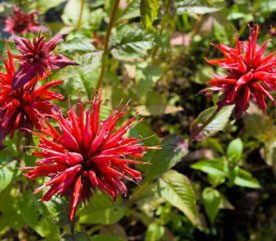Bee Balm in the Landscape
If you have a damp spot in the yard, fill it with bee balm. Then, in early summer, feast your eyes on the amazing display of flowers produced by the showiest member of the mint family.

This plant features shaggy blooms composed of many narrow, tubular flowers arrayed in 5-8 cm (2-3 in) wide topknots held on long stems. Colours include pink, lilac, and riveting reds that hummingbirds adore. The green leaves, sometimes tinged with red, give off a minty fragrance when crushed.
Bee balm thrives in moist soil, so it’s a natural companion for astilbes. In hot-summer areas, it needs partial shade and can be paired with impatiens, coleus, or wishbone flower. In colder climates bee balm will grow in partial shade or sun provided the plants are well mulched in winter.
In dry regions, they’ll appreciate regular watering; consider planting them near an outdoor water faucet where they can benefit from spillage. Its slightly gangly posture and ragged-looking blossoms make bee balm ideal for naturalistic settings. Keep the plants far from high-traffic paths, however, because they attract bees in droves.



